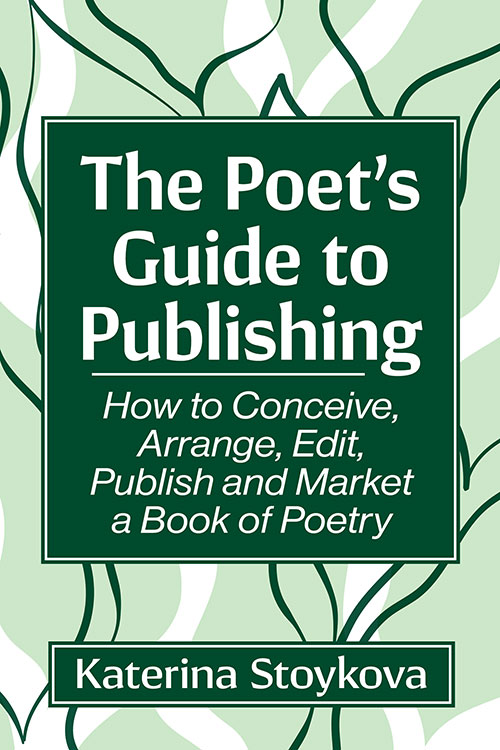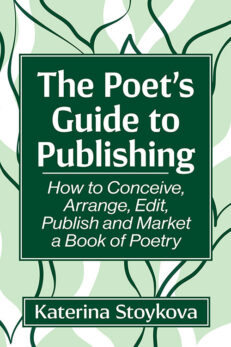The Poet’s Guide to Publishing
How to Conceive, Arrange, Edit, Publish and Market a Book of Poetry
$19.99
In stock
About the Book
This guide to publishing poetry is designed for the poet on a journey from producing a pile of poems to celebrating at a book launch. If you have been writing poetry for some time and have accumulated a volume of work, this guide is designed to meet you where you are in your book creation or publication process. It is organized into five sections to mimic the distinct phases of conceiving, arranging, editing, publishing, and promoting a poetry collection. Each section provides a mix of theoretical materials and practical assignments to demystify and ground the publication process.
About the Author(s)
Bibliographic Details
Katerina Stoykova
Format: softcover (6 x 9)
Pages: 189
Bibliographic Info: 2 photos, appendix, notes, bibliography, index
Copyright Date: 2024
pISBN: 978-1-4766-9415-3
eISBN: 978-1-4766-5243-6
Imprint: McFarland
Table of Contents
Introduction 1
Part 1—Concept 3
Projects 3
The Three Aspects of Writing Poetry 4
Aspect One: Instinct 4
Aspect Two: Technique 5
Aspect Three: Obsession 5
Working in Series 7
Indications of Successful Writing in Series 8
Indications of Unsuccessful Writing in Series 9
Maximizing the Chances for Success 10
Push and Pull Poems 12
Noticing Trends and Making Decisions 13
Gathering the Material 14
Discovering Themes and Topics 16
Assessing What You Have 17
Chapbooks or Full-Length Collections? 18
Metafiles 20
Formally Listing the Possibilities 22
Illustration 22
A Corny Illustration 23
If You Cannot Find a Theme 24
Qualities Needed at This Stage 25
Part 2—Arrangement 27
Combinations and Permutations 27
Reducing the Number of Combinations with Bonded Pairs 28
How to Bond Poems 29
Themeless Manuscripts 30
The Iterative Approach 31
Snapshots 32
Taking a Break 34
Goes Without Saying, but … 36
Avoiding Distractions and More 37
Book Organization 38
Titles 39
Dedications 43
Trigger Warning 44Table of Contents
44
Sections 46
Epigraphs 49
Choosing First and Last Poems 51
Epilogues 53
Notes Page 53
Acknowledgments Page 56
About the Author Page 56
Thinking Like a Book Buyer 58
Manuscript Worksheet 61
Qualities Needed at This Stage 63
Part 3—Revision 65
What’s Next? 65
The Value of Workshop 66
Forgive Me for a Few Personal Paragraphs 66
Tacit and Explicit Knowledge 69
Revision Checklist 70
Title 70
Perspective 70
Form 71
Lineation 71
Syntax and Real Estate 72
What Is Visually Important? 72
Repetition 72
Tense 73
Grammar and Punctuation 73
Sound/Rhythm/Rhyme 74
Giving Credit 74
Clarity 74
Ending 75
Title, First Line, Last Line Check 75
Have You Written the Entire Poem? 75
Beginner-Writer Giveaways 75
Overediting 76
What to Do with All These Revisions? 76
Editing the Manuscript as an Entity 79
Streamlining 82
Feedback 83
Warning One: Becoming Discouraged by Feedback 85
Warning Two: Perfectionism Paradise 85
Signs That the Manuscript Is Not Ready 85
Signs That the Manuscript Is Ready 87
Qualities Needed at This Stage 88
Part 4—Publication 89
Where to Meet Publishers in Person 89
Where to Submit Your Manuscript 90
What to Look for in a Publisher 92
Making a Good First Impression 95
Factors That Work in Your Favor 97
What Doesn’t Help 99
Contests 100
What to Look for in a Contest 104
Personal and Professional Goals 105
To Self-Publish or Not 106
What You Can and Cannot Control 109
What to Watch Out for in a Contract 111
What Do You Get in Return 113
The Anatomy of a Book Price 114
Direct Sales from the Publisher’s Website 114
Bookstore Sales 114
Sales on Amazon or Through a Distributor 114
Self-Publishing: Direct Sales 115
Self-Publishing: Bookstore Sales 115
Self-Publishing: Sales on Amazon or Through a Distributor 115
Paid Publication 115
What If the Press Does Not Offer You a Contract? 116
Qualities Needed at This Stage 117
Part 5—Promotion 119
Mic Check 119
Your Role Versus the Publisher’s Role 120
Obtaining Blurbs for Your Book 121
Creating a Marketing Plan 125
Clarify Your Marketing Goals and Objectives 125
Define Your Target Audience 127
Tap into the Experience of Others 128
Develop Your Budget and Timeline 129
How Long Should You Keep Up This Effort? 130
Announcing the Book 131
Readings 133
Book Launch 133
Joint Events 135
Reading Series 135
Other Ideas for Readings 136
Performing Your Own Poetry 137
Interviews 138
Teaching Classes 139
Utilizing Social Media 139
Web Presence 141
Reviews 141
Post-Publication Awards 142
Distribution and Sales 143
Book Fairs 144
Rites of Passage 146
The Issue of Control 147
What If You Hate It and Want to Hide? 147
Publisher Relations 149
After the Book Has Been Out for Some Time 150
Marketing Yourself Versus Marketing Your Book 152
Qualities Needed at This Stage 152
Afterword 153
Acknowledgments 155
Appendix: Extras 157
Obstacles, or How to Not Write Your Book 157
Obstacle One: Getting Stuck in One of the Stages 157
Obstacle Two: Not Making Your Book a Priority 159
Obstacle Three: Lacking a Plan 159
Obstacle Four: Waiting Too Long 160
Obstacle Five: Deciding Not to Publish 160
Obstacle Six: Wanting to Be Sure You’ll Succeed Before Investing Effort 161
Obstacle Seven: Waiting for the Right Time 161
Writing in Sprints 163
The Book Horrors 164
A Comprehensive Example 166
Bonus Parting Words 168
Notes 171
Part 1 171
Writing in Series 171
Chapbooks or Full-Length Collections? 171
Part 2 171
Combinations and Permutations 171
The Iterative Approach 171
Part 3 172
Forgive Me For a Few Personal Paragraphs 172
Part 4 172
Creating a Marketing Plan 172
Bibliography 173
Index 175
Book Reviews & Awards
• “How-to guides can often sound condescending when they don’t mean to be, or myopic beyond all recourse, yet Stoykova avoids these pitfalls gracefully and, at times, with genuine humor…. I think a range of readers will find this book teachable and re-readable.”—Washington Independent Review of Books
• “This craft book is like no other I have read. A look at the table of contents makes clear that this book covers subjects in detail that most craft books avoid.”—Good River Review






